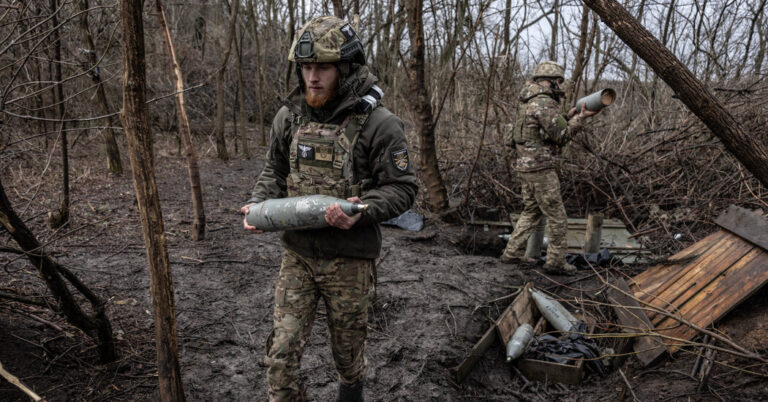Ukraine said on Wednesday that its forces had sunk a large Russian ship off the coast of Crimea before dawn, in what would be another powerful blow against the Russians at sea, as outgunned Ukrainian soldiers struggle to hold back bloody assaults on land.
The Ukrainian military released footage of the strike, which it said had resulted in the sinking of the 360-foot-long landing ship Caesar Kunikov, possibly complicating Russia’s logistical efforts in southern Ukraine.
The Ukrainian claim could not be immediately confirmed, but when NATO’s secretary general, Jens Stoltenberg, was asked about the attack, he called Ukraine’s campaign on the Black Sea a “great achievement.”
“The Ukrainians have been able to inflict heavy losses on the Russian Black Sea Fleet,” he said at a news conference in Brussels. Russia has lost more than a third of its fleet since the war began, according to Ukrainian officials and military analysts.
Russia declined to comment on the attack.
At the same time, however, Ukrainian ground forces find themselves in perhaps their most precarious position since the opening months of the Russian invasion.
“The enemy is now advancing along almost the entire front line, and we have moved from offensive operations to conducting a defensive operation,” Ukraine’s top military commander, Gen. Oleksandr Syrsky, told the German outlet, ZDF, in his first interview since being promoted to the post last week.
Russia has yet to achieve a major breakthrough on the front this winter. The epicenter of the current fighting is around the battered city of Avdiivka, a longtime Ukrainian stronghold in the east. Russian forces have broken through Ukraine’s defenses to enter the city in multiple locations and are threatening to cut off the main supply line for Ukrainian defenders.
The government in Kyiv has dispatched reinforcements, but soldiers fighting there have said it is unclear how long they can hold out. A growing shortage of ammunition has forced local commanders to ration shells, making it more difficult to push back the Russian advance.
Ukrainian soldiers fighting in the area said the other major problem is the sheer number of powerful aviation bombs Russian warplanes are dropping on them every day, demolishing even heavily fortified positions.
“They destroy everything,” said Serhii, the 40-year-old commander of an assault platoon fighting in the east who was identified by first name only in accordance with military protocol. “Nothing is left there. Plus the shock wave injures the guys, mutilates them, and so on.”
Dmytro Lykhoviy, the spokesman for Ukrainian forces around Avdiivka, said the Russians have deployed some 50,000 soldiers to the fight, including armored units engaged in fierce battles inside the city.
“The situation on the front line is dynamic and can change literally every hour,” he said. “Our troops are making every effort to hold their positions. In case the main logistics line is cut off by the enemy, our command has provided for backup supply routes.”
The calculation of how long to hold on and when to pull back from a position is a complicated one that Ukrainian commanders have wrestled with throughout the war. In some cases, a longer fight — like the drawn-out stand at a steel factory in Mariupol in the first months of the war — can be beneficial. That battle is now widely credited with slowing the Russian advance in other parts of the country.
But there is still bitter disagreement over Kyiv’s decision to fight for the city of Bakhmut as long as it did. Some senior American officials, as well as many Ukrainian soldiers who fought there, believe that the prolonged urban combat in Bakhmut drained Ukraine of critical resources ahead of its own counteroffensive.
Ukraine failed to break through the Russian lines in that counteraction, and it has increasingly been on its back foot since autumn.
General Syrsky, who was the architect of the defense of Bakhmut, appears to be keenly aware of the criticism.
“We cannot afford the attitude of Russian military commanders when they use the tactic of ‘meat assaults,’” he said in the ZDF interview, referring to sending waves of soldiers to storm positions, knowing many will be killed. “I would rather leave some positions, but I will not allow personnel to die.”
He said the primary objective of the Ukrainian defense is to “exhaust the enemy’s forces, inflict maximum losses.”
Another key part of the Ukrainian strategy this year, commanders said, is to develop their own weapons capable of hitting long-range targets critical to the Russian war effort, including oil and gas facilities inside of Russia.
Ukraine’s Prime Minister, Denys Shmyhal, said that at least 14,000 Russian assets were hit by Ukrainian drones during the past six months — with targets ranging from small Russian bunkers to large Russian warships.
The battle on the Black Sea continues to be the one bright spot in an otherwise trying moment for the Ukrainian military.
“Maritime drones paralyzed the enemy fleet in the Black Sea and guaranteed the security of the water logistics corridor,” Mr. Shmyhal said.
The drone that the military says sank the Caesar Kunikov is produced domestically. Ukrainian officials said that it punched a hole on the port side of the ship, causing it to flood and sink.
While Ukraine is scaling up its own weapons production and has repeatedly shown an ability to stretch its resources — using what it has at its disposal in creative ways against a far larger adversary — it is unlikely to make up for the gap left by Washington should Congress fail to approve renewed military assistance. A bill with $60 billion in aid has passed the Senate but is facing opposition in the House.
“At a time when the situation on the battlefield is becoming the most difficult, the main thing is to save the lives of soldiers and take them to another position,” Mr. Lykhoviy said. “To act flexibly.”

